The Microsoft Surface Book 2 (15-Inch) Review: Second Time's The Charm
by Brett Howse on December 21, 2017 8:00 AM EST- Posted in
- Laptops
- Microsoft
- Surface
- Pascal
- Surface Book
- Kaby Lake Refresh
CPU Performance
Microsoft offers the smaller 13.5-inch model with a Core i5-7300U on the base model, but once you add a GPU you get the Core i7-8650U. The 15-inch model comes exclusively with the Core i7 model. This is Kaby Lake Refresh, and the refresh is that Intel doubled the physical number of cores in the CPU, going from two to four. The Core i7 models keep Hyperthreading as well, meaning you get eight threads available. Prior to this fall, the only way to get this many cores was to go with the HQ series of processors, which have a 45-Watt TDP. That would be a bit much for a laptop with a detachable tablet, so the 15-Watt Core i7-8650U is a great way to add more multithreaded performance without increasing the heat output.
Microsoft has also included the same power management software as the Surface Pro, meaning you can choose your power setting as Best Performance, Better Performance, or Best Battery Life, with the latter being the system default. This adjusts the CPU efficiency by tweaking the PL1 and PL2 levels to lower and higher results, depending on the slider setting. When in the default state, the advantage is that the system fans almost never need to be used, meaning the system is nice and quiet, but if you’re doing something that’s processor intensive, turning it up will improve the performance, with the trade-off being noise. As you’d expect, the benchmarks were run in the Best Performance mode, and battery life testing was done in Best Battery Life.
Unlike the Surface Pro, there’s no Iris GPU available, although that’s not a surprise thanks to the much more powerful GPU available in the base, and the fact that Iris isn’t offered yet in the 8th generation products.
To test CPU performance, the Surface Book 2 was run through our standard suite of laptop tests, and compared to several similar models. If you want to compare the Surface Book 2 against any device we’ve tested, please see our Notebook Bench.
PCMark
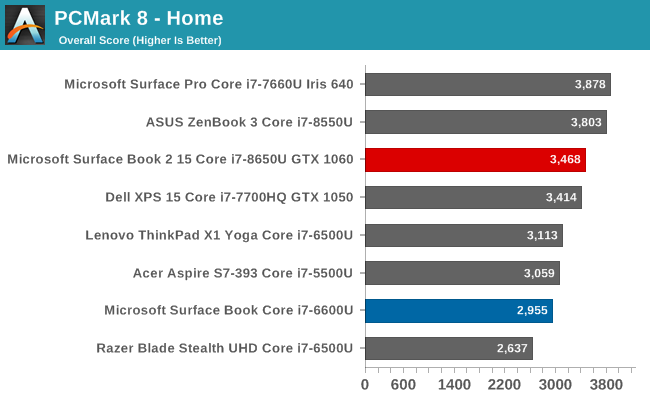
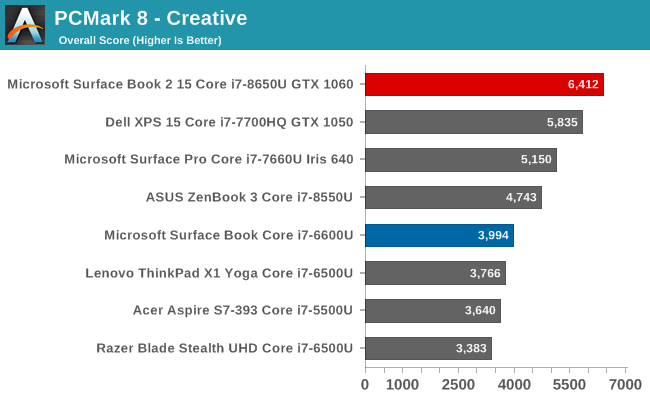
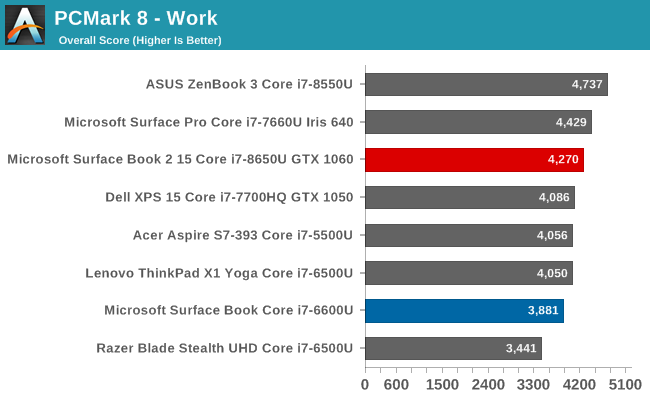
PCMark tests an entire system, from the CPU to the GPU to the storage, and all aspects of the device, including things like the display resolution, impact the results. The Surface Book 2 performs well on all of the tests, and it’s unsurprising to see it at the top for Creative, which has several GPU focused tests.
Cinebench
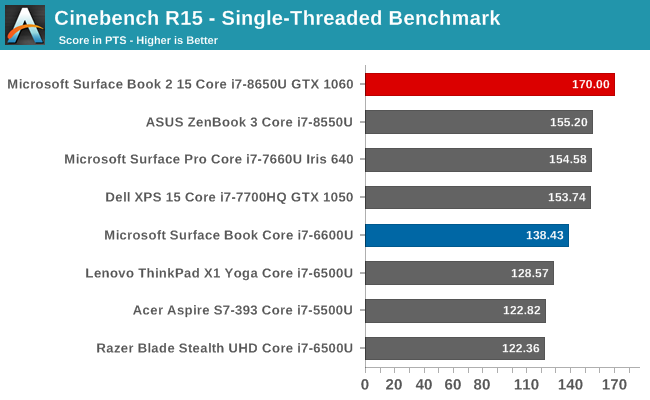
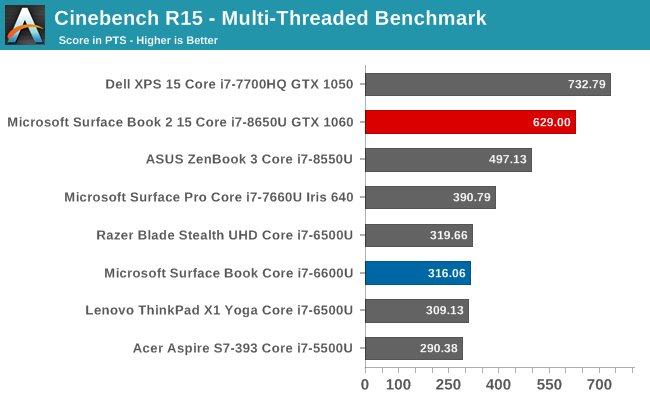
Cinebench is a rendering test which can use OpenCL, a single CPU thread, or all CPU threads to render the image. Our test focuses on the two CPU tests, and it gives us a great look at per-thread performance, and how that scales with more cores. Here the high turbo frequency of the Core i7-8650U delivers excellent single-threaded performance, and the multi-core result is also very strong. It can’t quite hang with XPS 15, but that has a 45-Watt TDP on its eight threads, allowing them to maintain a much higher turbo for the multithreaded result.
x264


Much like Cinebench, the x264 test converts a video using the CPU, and more cores with higher frequency generally wins the day here. The Surface Book 2 outperforms all other laptops with the 15-Watt TDP U series CPU in this test, but the higher TDP XPS 15 can still outperform it significantly when all cores are utilized.
Web Tests
The web is one of the most-used tools around, but performance on the web can be tied to the CPU as well as the browser itself. Over time, scripting performance in the browser continues to improve, and which browser you use will also impact performance and battery life. To make everything consistent, we utilize Microsoft Edge for all testing on Windows.
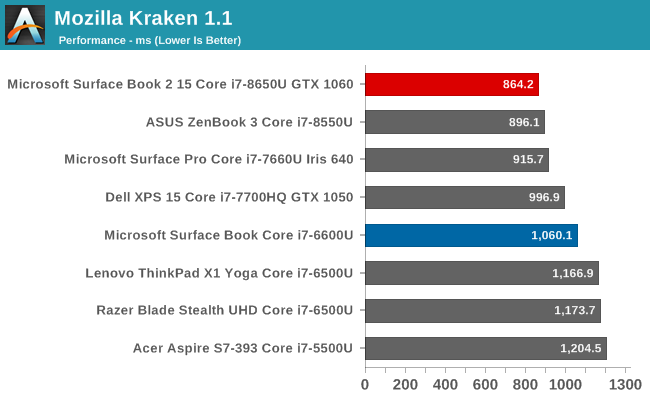
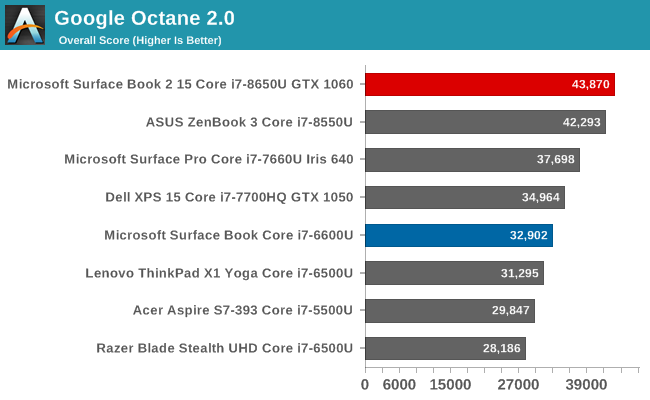
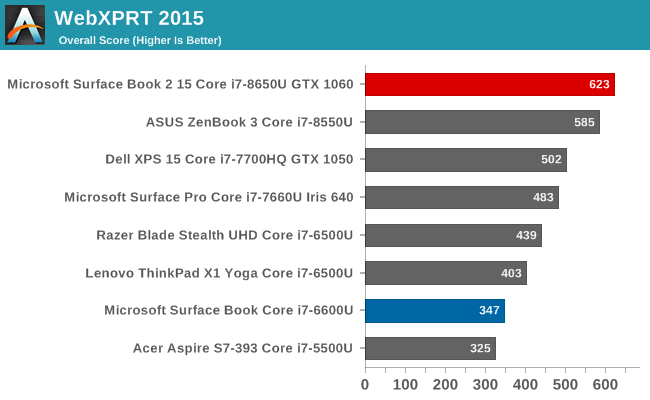
The Surface Book 2 has a slight CPU advantage over the ASUS ZenBook 3, and with that edge it creeps ahead in all of the web tests. The extra cores, as well as the updates to the browser with the Fall Creators Update, have made a significant difference over the older results. It would be nice to go back on some of these older devices to see how much of an impact the browser updates have made, if we still had the devices.
CPU Conclusion
As we saw with the ASUS ZenBook 3, the move to quad-core in the U series of Core chips has been very welcome. The performance increase is impressive over the older dual-core models, and although the eight threads run into the thermal limit quicker than the do on the higher-wattage HQ series chips, such as seen in the Dell XPS 15, the Core i7-8650U is still a very strong performer.
Storage Performance
The review unit for the Surface Book 2 shipped with the maximum drive size available, which is the 1 TB model. Thanks to the parallel nature of SSDs, this model should offer the best performance. The drive in the unit is a Samsumg PM961, which is a TLC based drive.
Performance is excellent for a TLC drive, and we do see the sequential write being affected by the TLC NAND, but all other aspects of the performance are excellent. In a device hitting this price target, a MLC version of this drive would be preferable, but it’s unlikely most people will notice the limits of this drive because it is quite good.


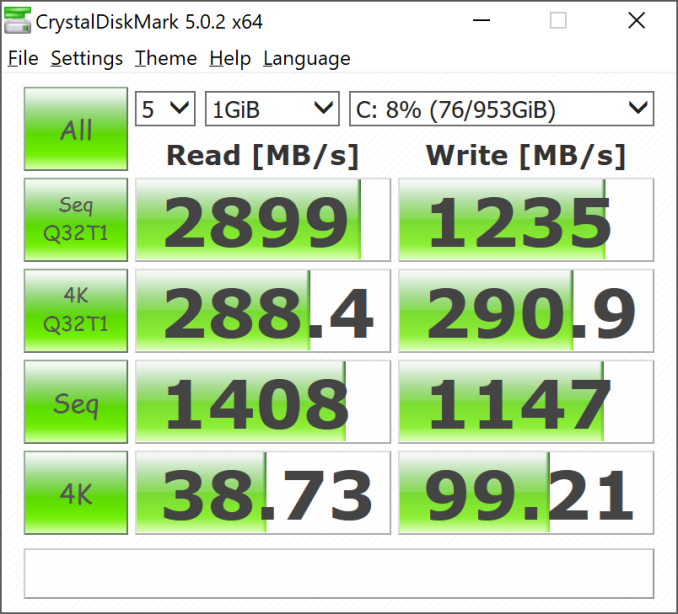








120 Comments
View All Comments
PeachNCream - Thursday, December 21, 2017 - link
It's a nice laptop, but the limited configuration options leave me a little miffed. I wouldn't have a use for the 1060 or 1050, but there's only one stripped down 13.3 inch model without the dGPU. It's limited to 8GB of RAM and 256GB of storage. That means that if I want 16GB and 1TB, I basically have to buy two and then switch the keyboard bases around between them if that would even work. Then I guess I could resell the unused parts, but it's a lot of pain to get the RAM and storage I'd want without the dGPU and I still wouldn't be able to get the 15 inch model. *sad panda*damianrobertjones - Monday, June 22, 2020 - link
...Or just buy the one with the 1050?? No-one on earth would buy two, to do what you've suggested.remosito - Thursday, December 21, 2017 - link
In my book no thunderbolt 3 instantly disqualifies for usage of expressions like "the charm"!!!aznchum - Thursday, December 21, 2017 - link
My conspiracy theory about the lack of thunderbolt 3 on the Suface Book 2 is probably to add viability to the 15" model. With thunderbolt 3 eGPU docks fairly widespread now, why would anyone pay extra for the 15" model? Lower pixel density without much additional real estate, half a pound heavier, and more expensive to boot.damianrobertjones - Friday, December 22, 2017 - link
Isn't it something to do with the available pcie lanes, offered by the cpu, with the lanes mainly being used for the dock? Hence no TB3 with blah blah.HStewart - Thursday, December 21, 2017 - link
Lack of Thunderbolt 3 for such an experience is shameless, but Microsoft has always been slow to act. Dell on the other hand has kept up.FatalError - Thursday, December 21, 2017 - link
Brett is there a chance to add benchmark results from the Surface Book with Performance Base that is using a 965m dgpu? It would be interesting to see how much difference there is between the 1050 and 965m - certainly at the current discounts the performance base might be the more attractive version for many users.Brett Howse - Thursday, December 21, 2017 - link
Sorry we requested a sample of the Performance Base model but were not able to secure one. No laptop we ever tested had the GTX 965M.Here's a comparison with the GTX 970M though and the SB2 trounces it:
https://www.anandtech.com/bench/product/1413?vs=20...
schizoide - Thursday, December 21, 2017 - link
I don't accept compromises on such an expensive premium product. I'd need at least 500GB of storage so that's $2900 for a computer without thunderbolt3. In 2018.erwos - Thursday, December 21, 2017 - link
I am a huge Surface fanboy, but even I've got to say that Microsoft's refusal to jump on the USB-C/TB3 bandwagon is inexplicable at this point. The Surface Connector never took off, this isn't an Apple situation where licensing is making them enough money to make it a hard choice. The SB2 should have had four USB-C/TB3/DP/charging ports, like the MBP. Or, if they just have to retain the Surface Connector, three of them.